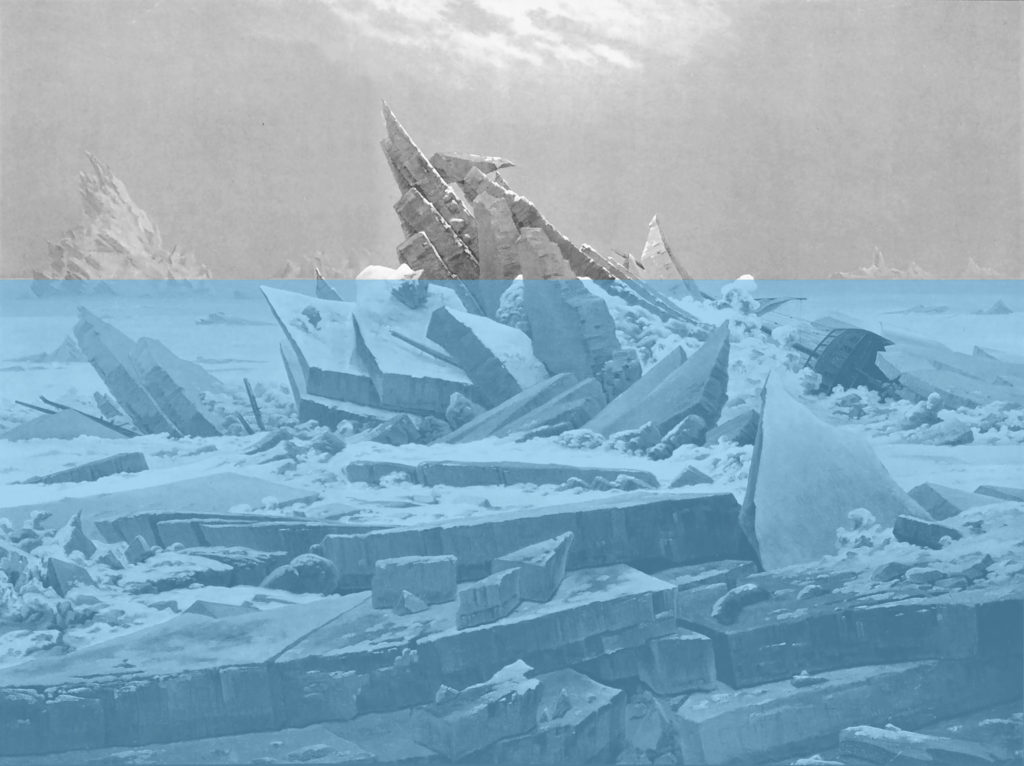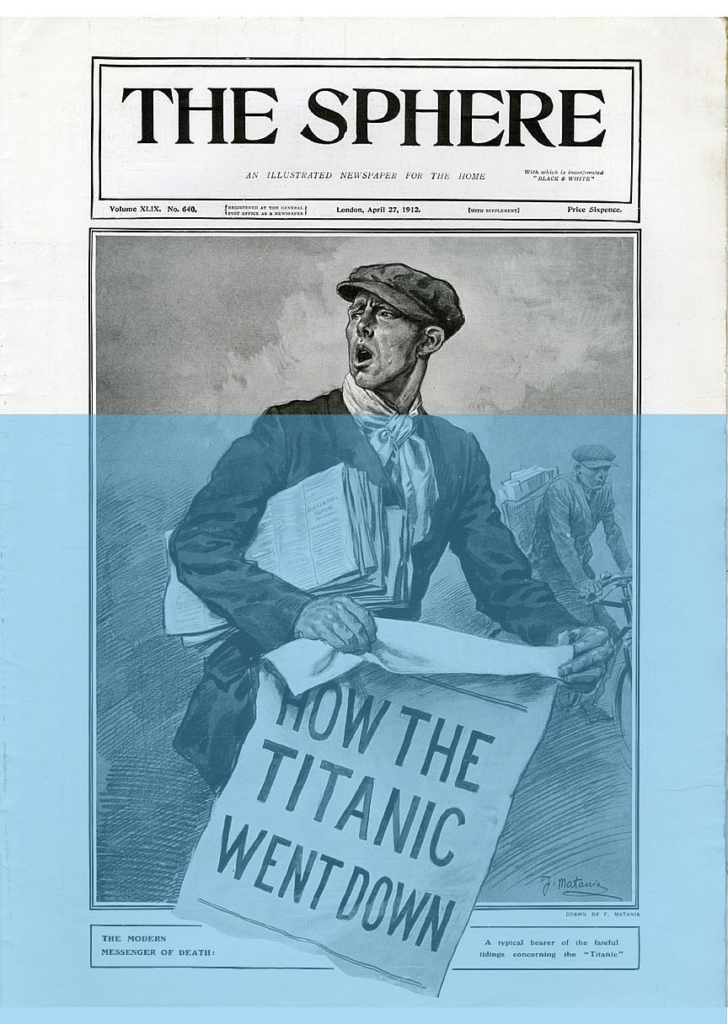Shipwrecks and visions
If you think about it there is shipwreck everywhere.
Petronius, The Satyricon
The metaphor around which this edition of the first Cima Norma Art Festival ‘orbits’ is the shipwreck, a metaphor that more than any other in the Western World is historically connected to the representation of human existence and to which the German philosopher Hans Blumenberg in 1979 dedicated one of his most fortunate books: Shipwreck with Spectator. Paradigm of a Metaphor for Existence. As was observed by Eckert Schäfer, from the very moment that man invented the boat as an instrument of exploitation and dominion of the marine element he also discovered it as the symbol in order to represent his existence in time. Starting out from antiquity sea ‘travel’ and the risks tied to this were taken up as being a ‘privileged’ metaphor for representing man’s destiny in a natural context which constantly threatened to overwhelm him.
Pleasant it is, when over a great sea the winds trouble the waters,
to gaze from shore upon another’s tribulation:
not because any man’s troubles are a delectable joy,
but because to perceive from what ills you are free yourself is pleasant.
In starting out from the celebrated incipit of Book II of the De Rerum Natura by Lucretius in which one has the description of the relief felt by the person who observes a shipwreck at sea while being safely ‘on land’, Blumenberg follows the evolution and transformation of this change over the course of the centuries. In underlining the continuous adaptations and variations undergone by the metaphor on the part of the various authors who took up the question, the German philosopher evidenced how in these transformations one saw the changes of the paradigm that presented themselves over time with regards to the ways we experience the world.

In fact, the image given by Lucretius is to be associated with an historical reality in which the sedentary aspect that was typical of the civilizations fundamentally based on agriculture was lived and experienced as a primary element of safety. Whatever form of nomadism or even only the need to temporarily abandon where one lived involved risks and dangers which rapidly required a return to one’s original place of residence. It is not fortuitous that the return ‘home’ was the essential element around which pivots the ‘plot’ of the misadventures, feats and trials that make up the most important poem of Greek antiquity, that of The Odyssey. And yet as Bodei continues in his explanation, land is after all the only one of the four elements put at man’s disposal by the Gods: access to the other three – water, air and fire – are forbidden to mankind and can only be had at the price of violating a mythical prohibition.
In the Sixteenth Century with the advent of the modern age and the affirmation of the “Copernican Revolution”, the position of the spectator who Lucretius identifies in the Epicurean sage who in an imperturbable way observes worldly events becomes increasingly more difficult to sustain. Man, by this time ‘enthralled’ by the journeys of discovery and exploration, becomes aware that he can no longer distance himself and must in person take on the ever-present risk which life demands. Safe or secure positions no longer exist. The difference between land and sea has been cancelled. In the words of Pascal: “we row a vast sea spurred on by one extreme to another, always uncertain and fluctuating”. From this point onwards the attitude of the spectator who observes the shipwreck with detachment, safe on land, begins to be looked upon as embodying a form of mean-spirited egoism. In the following centuries, when man is by now called on to no longer pit himself merely with natural storms but also with those of history, this ‘impassive’ serenity, this so-called withdrawal, appear to be increasingly more anachronistic: the figure of the shipwrecked victim and that of the spectator end up by becoming the same person. The spectator or observer is no longer safe and shielded on land but has himself become a shipwrecked victim.

With the crisis of certainty and the end of those “grand narratives” that characterized the Twentieth Century the metaphor as conceived by Lucretius underwent a new transformation. In fact, also ‘land’ ended up by being queried, coming to be submerged by the sea. Everything in modernity was by this time dominated by fluidity. Everything was liquid and there no longer existed harbours and land that were shelters. Given that the possibility of a ‘safe harbour’ no longer existed a journey had neither a beginning nor an end. As pointed out by Karl Jaspers, one had arrived at “an infinite shipwreck”. And so we have the final image of the book by Blumenberg: even the boat on which the shipwrecked victim finds him or herself may have been built and can constantly be repaired only if we begin with fragments retrieved from the sea itself. And, obviously, these fragments can only be provided by previous shipwrecks.
If on the bases of Blumenberg’s considerations we now more closely come to observe the way with which the shipwrecks have ‘haunted’ the imaginary of society over the last two centuries then we can note how during the first decades of the Nineteenth Century, thanks to Romanticism, we have the termination in some way of the heroic age of the shipwreck which the memorable travels of oceanic exploration and discovery of the Sixteenth Century had begun. In the works of romantic painters like Vernet, De Loutherbourg, Turner and Caspar David Friedrich we are faced by the terrifying – and at the same time sublime – spectacle of the stormy sea which, notwithstanding the enormous disparity of strength with regards to nature, man faces with a titanic will of self-affirmation, well-aware of the tragic epilogue which may await him. Even though this determination, transformed into insatiable ‘thirst’ and blind yearning for power will culminate in dragging Capitan Ahab to the depths of the ocean following the final battle with the giant white whale in Melville’s novel published in 1851.


Between the close of the Nineteenth and the beginning of the Twentieth Centuries, given that the seas and oceans had by then been fully explored with nothing left unexplored, although perhaps with the exception of the Polar regions where the expedition by Franklin followed by the one by Shakleton both came to vividly “shipwrecks” in the ice. In the previous centuries boundless territories had been occupied and colonized. Thousands of hectares of land had been deforested and tilled, new roads and railways had been created, one had the founding of new villages, towns and cities and at this point, in order to regain these new possibilities of this second industrial revolution, what was necessary was a strong and consistent demographic injection. They were, above all, the desperate masses of European immigrants which arrived by sea in the new lands of the United States, South America and Australia, the new victims of shipwrecks. These shipwrecks of the large steamships and transatlantic liners which with their immense size undauntingly challenged the vast and turbulent oceanic expanses thanks to the new technological strength of the naval industry were almost never due, however, to the unleashing of the forces of nature but were almost always the result of human error, breakdowns and accidents which were so often caused by greed on the part of the shipowners. They were terrible events that caused a great number of deaths, events that remained at length in popular memory. Besides the Titantic we can mention the Sirio, the Princess Mafalda, the SS Bourgogne and the Utopia. If during the years of World War II the shipwrecks or sinkings formed part of the innumerable episodes of various kinds that on a daily basis caused death and destruction as the consequences of an all-out war that didn’t even spare the seas, during the first decades of the post-war period the shipwrecks became less frequent and found less space in the news bulletins. It is true that the sea tragedies continued but their influence on the popular imagination became a little less intense (with the exception, perhaps, of the sinking of some large cruise liners like the Andrea Doria). What did strike popular feeling in these decades were above all the vicissitudes of some figures that in the oceans brought their tragic destiny to a close – a destiny suspended between heroic aspirations of a romantic imprint and a vocation to commit suicide. Between the 1960s and 1980s of the last century, when the great confrontations of man and the forces of nature seemed only able to survive in the challenge represented by solitary transoceanic crossings, a series of both mysterious and ambiguous ‘shipwrecks’ attracted public attention. From among these individuals who with the sea found an ideal stage for a disappearance that was almost always enveloped in a ‘blanket’ of uncertainty we find persons like Donald Crowhurst, Bas Jan Ader and Alain Colas. They all disappeared mysteriously as had the Italian physicist Ettore Majorana at the close of the 1930s.

In those decades marked by the Cold War but also by the increasing technological development and the ‘space race’, popular imagination was however moulded above all by the dreams and the nightmares proposed by science fiction and, in consequence, inevitably directed beyond the boundaries of the earthly globe. The new seas and oceans to sail became the infinite sidereal expanses for which the ships were transformed in increasingly more gigantic and hypertechnological space-ships.
From this point on the image of the shipwreck victim became that of the astronaut who, on having lost contact with his own spacecraft, fluctuated alone in the absolute blackness of the cosmic void (as in 2001: A Space Odyssey). At the same time real ships like the Japanese Yamato battleship sunk during the Second World War, re-emerged from the marine depths amidst the technicolor spraying of the animated film series and they flew away towards the unfathomable depths of the universe.

Although the “end of the story” – at least the terrestrial one – hadn’t yet arrived and so between the middle of the 1990s and the opening years of this century the news chronicles brought our feet firmly back to earth – or better, back into the water – contributing yet again to rendering the metaphor of the shipwreck something very actual. The environmental disasters caused by the sinking of a number of oil tankers with their vivid images of marine birds transformed into bituminous monsters represented an alarm bell for the irreversible and dramatic damage which mankind’s action can cause to the fragile equilibria on which the Earth’s ecosystem is based. An alarm that in recent years has become a real emergency in being faced by the increasingly more evident effects of the climate change taking place. From among these effects one envisages the wholesale melting of the artic icecaps which will lead to a rise of sea levels and, consequently, to the “shipwreck” of many coastal areas throughout the world, today often densely populated. However, in the 2000s the image of the cormorant trapped in tar was soon substituted in the collective imagination and consciousness by those pictures of the bodies of migrants ‘deposited’ by the waves on Mediterranean beaches, such as that of the small Alan Kurdi which in 2015 gave rise to an outburst of emotion on the part of Western public opinion. The intensification of the migration flows towards Europe which during the 1990s above all involved the populations of the former Yugoslavia and which in the first years of this century were substituted by the peoples from Africa or the Middle East dramatically brought (back) to the fore – also in numerical terms – the theme of the shipwreck. The almost daily bulletin of the shipwrecks that often occur in the open sea away from cameras, has, with its almost always approximate numbers, become a sort of background noise which in some way we have accustomed ourselves to. Offsetting or counterbalancing this “normality” of tragedy we had the incredible emotional reaction and media echo caused in 2012 by the shipwreck of the cruise liner Costa Concordia just off the coast of Isola del Giglio, something that was both a tragedy and a farce.

The most recent event to which the metaphor ‘shipwreck’ would seem to perfectly embroil us is the pandemic due to the diffusion of the Coronavirus in which we are still immersed. In our opinion the metaphor of ‘war’ which many people have used to describe our relationship with the spread of the contagion appears to be totally inappropriate. In fact, yet again the metaphor of the shipwreck shows itself to be the one most suited for throwing light on a situation in which mankind finds itself confronted by the overwhelming forces of nature. Although this time the shipwreck could be caused by a virus that spreads by way of the liquids of our own bodies like saliva or tears and that in the words of many patients provokes a lack of air, often compared to the experience of drowning. During a period that has often been defined as Anthropocene, mankind ends up by synthesizing in itself all of the figures and elements to be found in the ancient Lucretian metaphor which embodies – at one and the same time – the shipwreck, the spectator, the sea and land. The only solution for stemming the contagion is the suspension of humanity’s social nature – that is, its most intimate essence – and solitary confinement (isolation or “made into an island”) inside the perimeter of one’s home transformed into a sort of desert island for billions of new Robinson Crusoes. Nevertheless, once again and even if more than adequately equipped technologically speaking, the confrontation with the forces of nature appears to be unequal: the consequences of the viral storm can in the years to come provoke innumerable individual and group “shipwrecks” in many different fields: ranging from the economy to politics, social life and culture.
On the basis of this observation it proves evident that the metaphor of the shipwreck has once again become actual, again managing to condense the spirit of the times in which we live, together with the consequences that these same times have on our existence. It is hardly fortuitous that the Franco-Lebanese writer, Amin Maalouf, in starting out from considerations in part analogous to those we have developed, entitled his most recent book – published at the end of 2019 – The Shipwreck of Civilizations.

Returning at this point to the Lucretian metaphor, however, we must remember that together with the shipwrecked victim there is from the very beginning another important figure, that of the spectator. If during the course of the Twentieth Century, as we have seen, these two figures have ended up being superimposed, reassuming themselves in the image of the shipwreck victim adrift in an infinite sea from which any trace of land has disappeared, the only possibility remaining to one’s sight in order not to remain imprisoned in the hypnotic and annihilating spectacle of the sea’s waves is to project his gaze beyond the reality that surrounds the eye. The gaze of the shipwrecked spectator must, in other words, becomes vision, it must project itself into the future in trying to imagine the solutions that thanks to the remains of previous shipwrecks permit constructing the only ‘foothold’ that the sea still offers: an island where even only temporarily it is possible to be able to dock. However, this requires the force of ideating new forms of collaboration not only with the other wreck victims but also with the fauna and flora which differing from him are ‘at home’ in those waters. After all, as the Italian philosopher Massimo Cacciari observed, a shipwreck isn’t always a sign of misfortune or mistake. In fact, often it is providential as when in the case of Bacon’s New Atlantis it leads to the discovery of a utopian island. And it is perhaps only the rebirth of a renewed and consciously utopian thought that can help us in this general ‘shipwreck atmosphere’. Precisely for this reason we have decided to give the title of Shipwreck and Visions to this Festival because what we need in this point in time are visions.


Supported by:
- Pro Helvetia
- Stiftung Landis & Gyr
- Cantone Ticino, Fondo Swisslos
- Banca Stato
- La Mobiliare
Agenzia generale Bellinzona
Michele Masdonati
Agenzia generale Lugano
Marco Ferrari - Fondazione Fidinam
- SIP Industrial Promotion SA
- Bellinzonese e Alto Ticino Turismo
- Winteler
- Biauto sa
- APG l SGA
- Videocompany
- AGEvent
- Battaglia SL
Media partner:
- Corriere del Ticino
